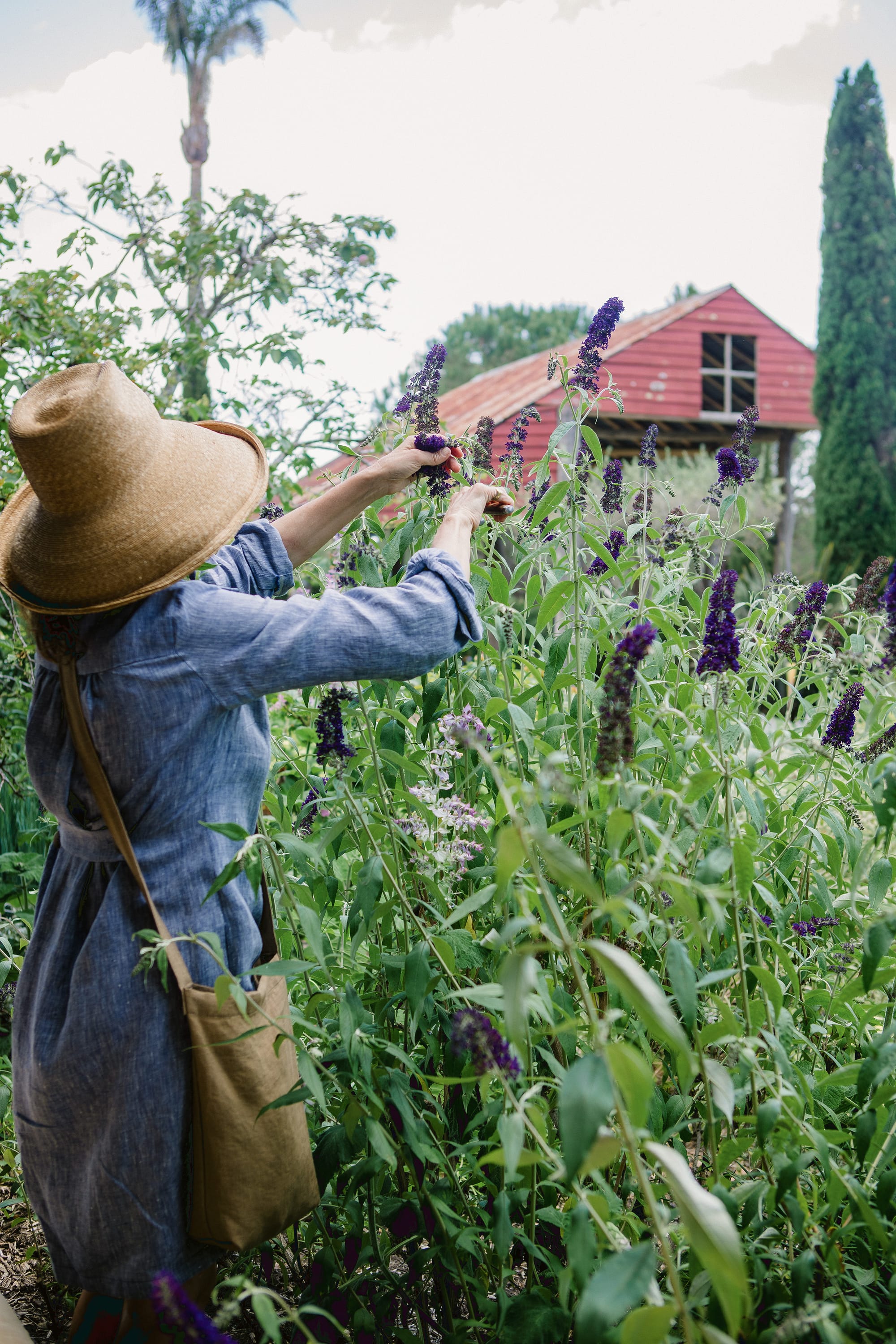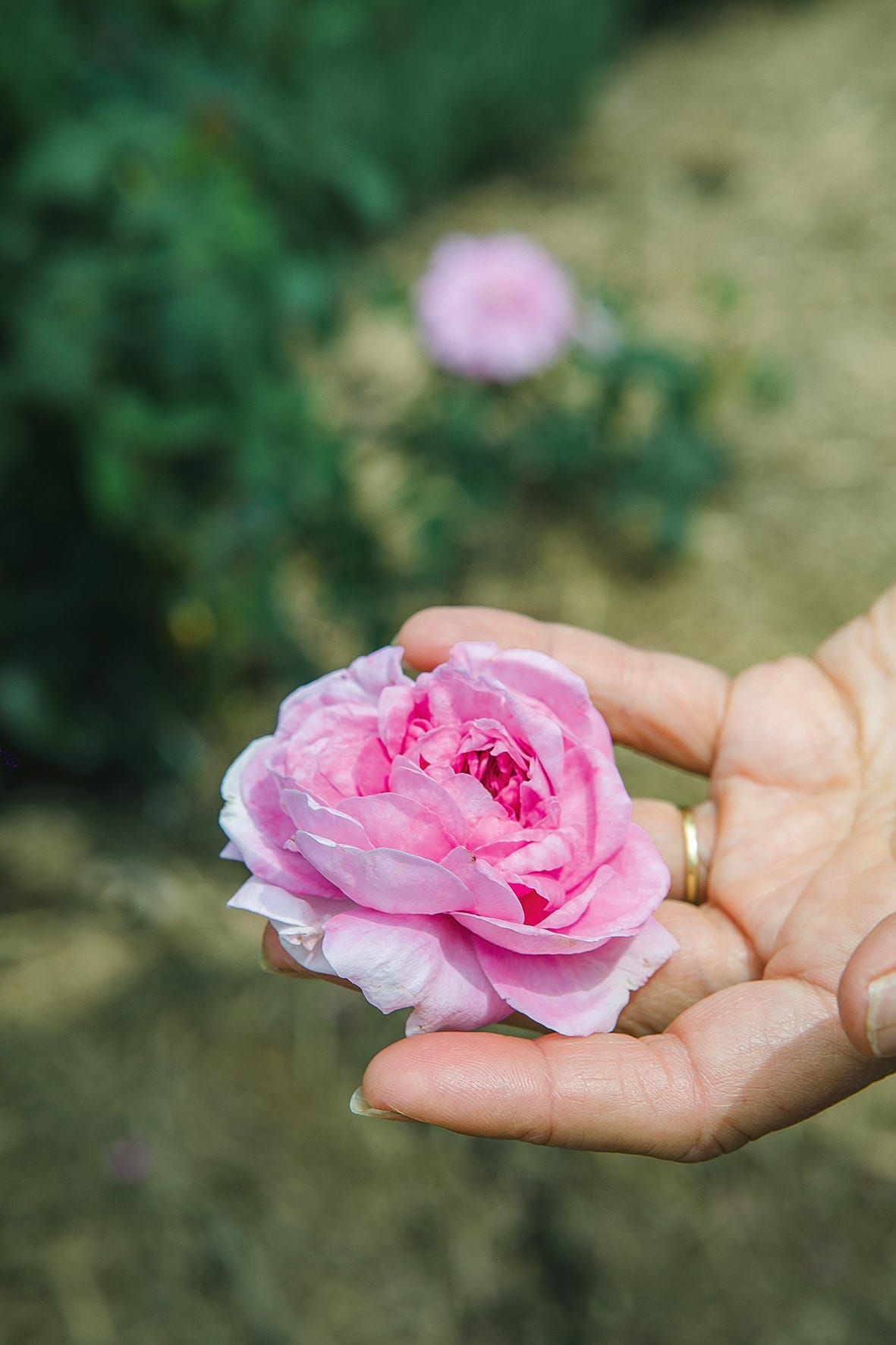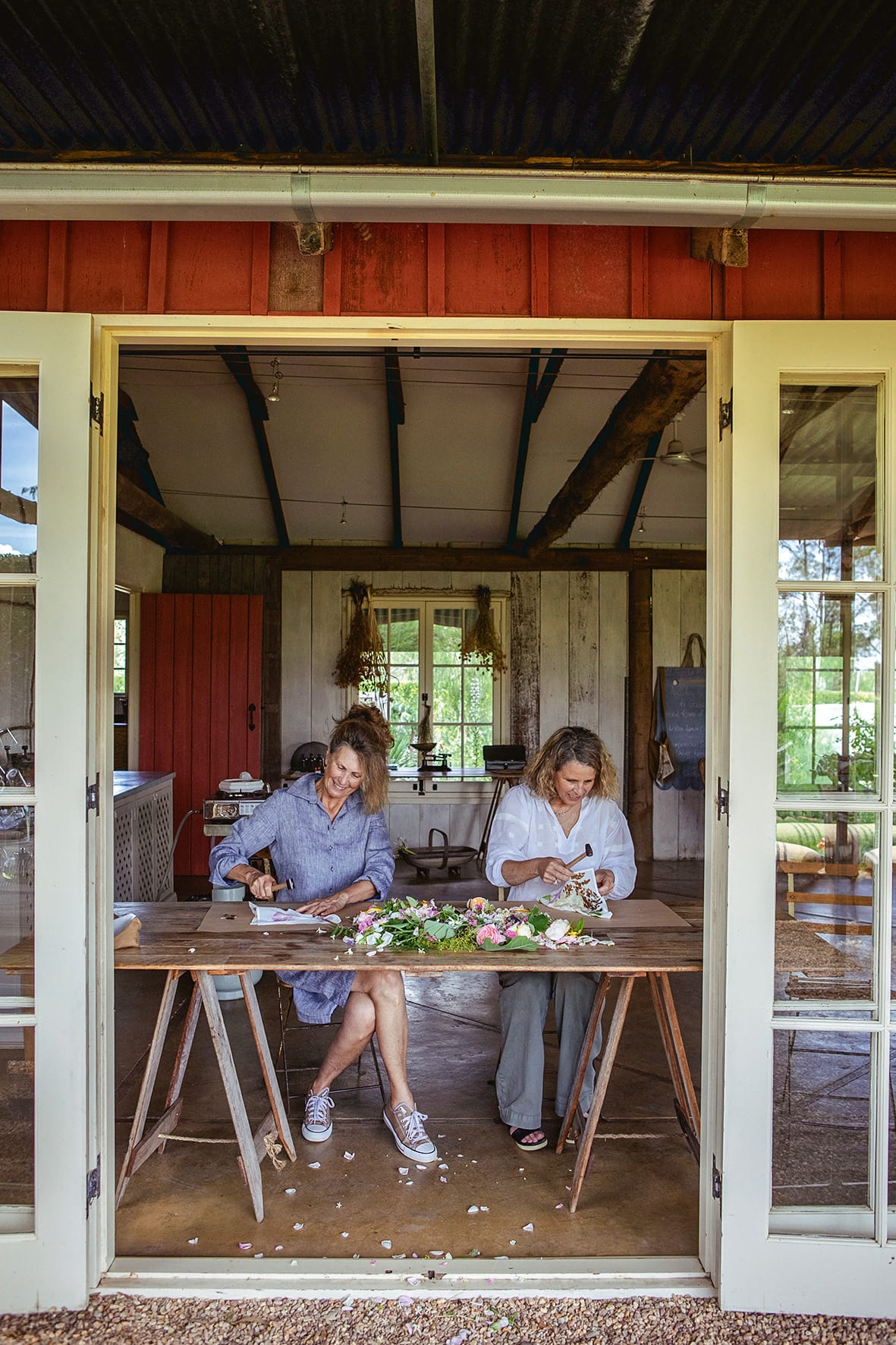
Interior designer, gardener, events coordinator … Mickey Robertson wears many hats. Her latest passion? Distilling the essence of garden and memory.
Words Sarah Turnbull
Photography Luisa Brimble
A LITTLE bottle of scent on a skirted dressing table in her mother’s bedroom fascinated Mickey Robertson as a child. The label, illustrated with a bouquet of flowers, was faded and foxed – goodness knows how old the perfume was. Yet the fragrance was heavenly. Robertson closes her eyes remembering. “It was an orange lavender concoction, totally intoxicating. When my mother was at work I used to go in and take the lid off and smell it. We lived in a flat and the essence was the nearest thing to a flower bed.”
It was the beginning of a love affair with fragrance that led her to England for a wild perfume workshop run by master distiller Amanda Saurin. Those few hours five years ago proved life-changing. Enthralled, Robertson confided her long-held dream to bottle the aroma of her beloved garden. Saurin told her that she needed an alembic. Huh? A what? Robertson laughs at the memory. “I was absolutely clueless. I had no idea what I was getting into.”
After studying distillation and years of experimentation, she’s ready to share her knowledge with others. At day-long workshops organised for groups of friends or work colleagues, she guides participants through the entire fragrant process, from picking the blooms to brewing the “botanical water”. Less potent than perfume, it’s not for wearing, nor can you drink it. The point of this scented water lies in the making and the experience – that’s what brings me to Glenmore House one bright morning in late spring.




Robertson sorts plants for the distillation pot (below); David Austin ‘Jude the Obscure’ roses; the garden at Glenmore House. Photography Luisa Brimble.
Home to Robertson and her husband Larry, the rural property lies 80 kilometres south-west of Sydney in the foothills of the Razorback Range near Camden. When the couple bought it in 1988, the farm had been vacant for six years and the colonial-era buildings were crumbling and uninhabitable.
The stone cottage, restored and enhanced by additions including a shaded verandah, radiates homely elegance. Winding footpaths link the rebuilt farm buildings – the dairy and stables, and the barn, whose rotting timber walls had to be replaced. And the garden is glorious. Designed and created by the Robertsons, it’s a canvas of colour and contrasts. Peppercorn trees hang willowy curtains of green foliage; blue-grey Agave americana are strikingly sculptural. Grass plumes shimmy between salmon-pink canna lilies and crimson pompom dahlias. Deeper in the garden, a bronze figure sculpture by Sydney artist Helen Leete catches the sunlight among golden elms.
Hosting events at the property is one of Robertson’s principal activities and everything from author talks to art exhibitions are held in the former dairy, a light-filled space with its own kitchen where she prepares food for guests. Her training as an interior designer – she still does consulting work – is apparent in the details. Sprigs of apple geranium hang on the backs of doors; on the verandah table, bunches of dried poppy flowers double as decoration and garnish – at lunch we tap the seeds onto goat’s cheese. Most of what we eat during the day Robertson has made using produce from her vegetable garden: lemon syrup cake, chilled carrot and orange soup sprinkled with chive flowers, fennel frond pistou, which we dollop on home-baked soda bread.

Making botanical water requires smaller quantities of plant material than concentrates such as perfume and essential oils. Even so, a new field-sized garden had to be created at Glenmore House to supply enough flowers to distil. Now in its third year, it ought to be at its peak during our visit but an unexpected spring heatwave caused many of the rose varieties to bloom early.
Still, the hedge-like rows of shrubs are a sensory delight. “Smell this,” urges Robertson, plucking a pillowy pink bloom with a sweet aroma reminiscent of lychees. “I love, love love Albertine rose.” David Austins, damasks, bourbons, gallicas, albas … she talks about them as if they are dear friends. “This is Sarah Van Fleet. She’s a rugosa, very tough, very drought-resistant. It would be hard to be without her.” To provide green scent notes, there’s a row of aromatic plants including apple geranium, clary sage and botanical tulip. The sixth and last row, which borders bushland, is devoted to native plants, including Australian mintbush and tea tree.
Equipped with sun hats and satchels, we spend the morning running our hands along the lavender heads, sniffing and picking. Striding ahead, Robertson’s conversation skips from rose history to soil facts and is punctuated with the occasional squeal of delight. But her exuberance belies a thoughtful seriousness.

Many years of gardening have not only transformed Glenmore House, they have also changed her. The former city girl, who lived in Woollahra until her 20s, now feels profoundly connected to this land, this patch of earth. At 61, her approach is informed by the Indigenous practice of caring for country as well as contemporary research into responsible farming. Certain books have been essential to her education, Charles Massy’s Call of the Reed Warbler and Soil by Matthew Evans among them. “It’s been a steep learning curve,” she admits, “but I understand growing now, I understand nurture and plants, I understand the cycle. I actually know what I’m doing. Thirty years on, I am a gardener.”
Awareness of the interconnectedness within the natural world means she thought deeply before creating the field of flowers. Was it the right thing to do environmentally? How could it be done in the most water-conscious, least impactful way possible? To prepare for planting, vast quantities of float rocks had to be removed from the paddock. Sandstone lumps continue to rise to the surface and Robertson collects them at the end of the rows to allow soil and rock to “knit back together”.
Distillation is an age-old process variously claimed by scholars to have started with Arab alchemists, the Greeks or the Romans to produce scent as well as medicinal tonics and balms. Robertson’s passion for the historical context is apparent when she introduces me to Hildegard, the alembic still she named after Hildegard of Bingen, medieval abbess, composer, poet, health advocate and skilled herbalist who in 2012 was canonised as a saint.
When the apparatus first arrived, its many parts were confounding. “She was like something from Mr Squiggle,” laughs Robertson, “I had no idea how to put her together.” Help came in the form of a Zoom call with Jill Mulvaney, founder of the Alembics Lab in New Zealand, who talked her through it.
Now Robertson assembles the copper pipes, pots and cylinders with ease. As an experiment, today we’re distilling the leaves of apple geranium. Their aroma is not fruity but lively and herbal – interesting, though not something I’d necessarily want to bottle. The fresh sprigs have been packed into a dense bed in the column, part of a large gourd-shaped vessel connected to a second receptacle by a vine-like tube.
Curved and lustrous, Hildegard is rather beautiful. Robertson explains how the heated water turns to steam, pushing through the perforated column holding the plant material into the tube, where it descends like a rain cloud before turning into water again. It’s pure science yet, as the alembic burps and gurgles, I half expect a genie to whoosh out.
What emerges instead, in a slow piddle, is a litre of distilled botanical water. The fragrance is a surprise, at once more concentrated and more mellow than the furry foliage. I can smell apple now, I exclaim, and Robertson nods. It gives her a kick to see people shriek with glee over an aroma or to hear a group toss around words in search of the exact thing a scent reminds them of.
The plants used in workshops depend on what is in flower; so far she has distilled rose geranium, orange blossom, lavender and damask rose, as well as more experimental concoctions. Each participant takes home a bottle of the botanical water. Robertson hopes that a few puffs of the garden scent, sprayed into the air, will help people relive the joy they felt in the moment.




Gertrude Jekyll rose; Hildegard, the copper still that makes botanical water from flowers and foliage; distillation prep in the rebuilt dairy. Photography Luisa Brimble.
Like most large-scale creative projects, Glenmore House is one part romantic vision, two parts backbreaking labour. The Robertsons have done most of the work themselves. In the beginning there was no running water outside and everything had to be watered using buckets. The vegetable garden continues to require daily maintenance. Workshops demand a great deal of preparation. Busy weeks are followed by weekends spent pruning, bundling, composting, weeding.
It strikes me that Robertson had plenty on her plate without plunging into distillation, yet there’s no denying her passion. Talking about the project makes her eyes glitter; her language grows lyrical. More than once she refers to magical evenings in the flower field when the air is infused with “aromatic conversations”. Experiencing the symphony of scents, the exchange of energy between one living thing and another, is one of the serendipitous rewards.
“All these funny things I do give me tremendous joy,” Robertson says. “The many tasks give me a great sense of fulfilment, of contentment.” She uses the word deliberately, preferring a sense of groundedness and belonging to the much-hyped pursuit of happiness. “When I’m filthy and aching with bits of plants caught in my hair, that’s when I’m most content.”
She puts her nose to a beaker of botanical water and her thoughts shift, perhaps to the little bottle of sweet fragrance that once sat in her mother’s bedroom. Robertson still has it somewhere, all these years later, though there’s barely a drop left. “What I’m doing today is just an extension of what I always wanted,” she says, “from since I was very young.”